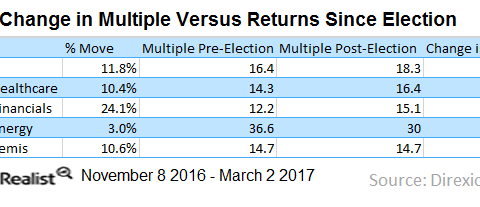How Trump’s Proposed Policies Have Caused Sector Divergence
Despite the stellar run that financials (FAS) have had since the US elections in November 2016, financials are trading at very reasonable levels.
April 4 2017, Published 9:02 a.m. ET

Direxion
Trump-induced Sector Valuations Offer Opportunities
Whether you like President Trump’s policy agenda or not, it has certainly created a lot of movement in the marketplace. Sectors have responded differently to the administration’s proposals. Now is a good time, with the market at or near all-time highs, to evaluate moves in different sectors and see how they compare to other sectors, to the market as a whole, and to Trump’s characterization of the sectors. Traders have to decide what they think about future growth under Trump’s presidency, how quickly and completely policies can be enacted, whether the valuations make sense against the interest-rate backdrop, and other considerations. Direxion can offer traders and tactical managers the tools necessary to benefit from these decisions with directional sector ETFs.
Markets are moving up, but at a different pace and with new valuations
Equity markets have all rallied since the US presidential election. The S&P 500 has risen over 11%, but different sectors have outperformed or underperformed. Earnings season and the Federal Reserve’s moves and expectations have offered further food for thought. But the question is: have some sectors moved too far, too fast, based on valuation?
Take a look at the chart below to see how sectors have moved and how they have fared compared to the S&P 500.
We can see the different sectors’ moves in the above chart. Semiconductors and financials have outperformed while healthcare and energy have underperformed. The more compelling component of these price moves, however, is valuation. Take a look at the chart below to see how different sectors’ valuations have changed since the election in addition to the sector moves. All these figures are next-12- month forward multiples.
Note that some sectors have recorded outsized moves with commensurate shifts in valuation while others have been more mixed. We examine each sector below to see why some moves make sense based on recent results and why some relate more to future Trump administration goals. Assessing which sector is part of each group can help investors decide which direction they want to bet on.
Market Realist
Despite the stellar run that financials (FAS) have had since the US elections in November 2016, financials are trading at very reasonable levels. That’s perhaps due to forward earnings estimates for financials, which are strong, given the rising interest rates. It could also be due to the proposed removal of the Dodd-Frank Act. Both of these factors have squeezed bank margins over the last seven years.
Meanwhile, semiconductors (SOXL) have underperformed, returning 10.6% since the elections. Those returns have come in the form of earnings growth.
The energy sector (ERX) appears quite expensive since some energy companies are in the red. That raises the overall sector PE (price-to-earnings) ratio.
In the rest of this series, we’ll take a look at the financial, healthcare, and energy sectors and what opportunities they could bring.
